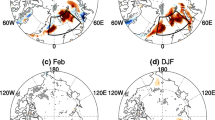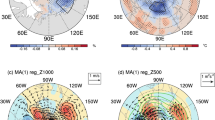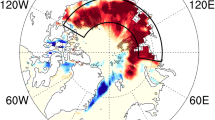Abstract
This study reveals a close relation between autumn Arctic sea ice change (SIC) in the Laptev Sea-eastern Siberian Sea-Beaufort Sea and subsequent spring Eurasian surface air temperature (SAT) variation. Specifically, more (less) SIC over the above regions in early autumn generally correspond to SAT warming (cooling) over the mid-high latitudes of Eurasia during subsequent spring. Early autumn Arctic SIC affects spring Eurasian SAT via modulating spring Arctic Oscillation (AO) associated atmospheric changes. The meridional temperature gradient over the mid-high latitudes decreases following the Arctic sea ice loss. This results in deceleration of prevailing westerly winds over the mid-latitudes of the troposphere, which leads to increase in the upward propagation of planetary waves and associated Eliassen-Palm flux convergence in the stratosphere over the mid-high latitudes. Thereby, westerly winds in the stratosphere are reduced and the polar vortex is weakened. Through the wave-mean flow interaction and downward propagation of zonal wind anomalies, a negative spring AO pattern is formed in the troposphere, which favors SAT cooling over Eurasia. The observed autumn Arctic SIC-spring Eurasian SAT connection is reproduced in the historical simulation (1850–2005) of the flexible global ocean-atmosphere-land system model, spectral version 2 (FGOALS-s2). The FGOALS-s2 also simulates the close connection between autumn SIC and subsequent spring AO. Further analysis suggests that the prediction skill of the spring Eurasian SAT was enhanced when taking the autumn Arctic SIC signal into account.


















Similar content being viewed by others
References
Ambaum MHP, Hoskins B (2002) The NAO troposphere-stratosphere connection. J Clim 15:1969–1978
Andrews DG, Holton JR, Leovy CB (1987) Middle atmosphere dynamics. Academic Press, Dublin p 489
Baldwin MP, Dunkerton TJ (1999) Downward propagation of the Arctic Oscillation from the stratosphere to the troposphere. J Geophys Res 104:30,937–946. https://doi.org/10.1029/1999JD900445
Baldwin MP, Dunkerton TJ (2001) Stratospheric harbingers of anomalous weather regimes. Science 294:581–584. https://doi.org/10.1126/science.1063315
Bao Q, Coauthors (2013) The flexible global ocean atmosphere-land system model, spctral version 2: FGOALS-s2. Adv Atmos Sci 30:561–576
Beniston M (2004) The 2003 heat wave in Europe: a shape of things to come? An analysis based on Swiss climatological data and model simulations. Geophys Res Lett 31:L02202. https://doi.org/10.1029/2003GL018857
Charney JG, Drazin G (1961) Propagation of planetary-scale disturbances from the lower into the upper atmosphere. J Geophys Res 66:83–109
Chen W, Graf HF, Takahashi M (2002) Observed interannual oscillations of planetary wave forcing in the Northern Hemisphere winter. Geophys Res Lett 29:2073. https://doi.org/10.1029/2002GL016062
Chen W, Takahashi M, Graf HF (2003) Interannual variations of stationary planetary wave activity in the northern winter troposphere and stratosphere and their relations to NAM and SST. J Geophys Res 108:4797. https://doi.org/10.1029/2003JD003834
Chen S, Chen W, Wei K (2013) Recent trends in winter temperature extremes in eastern China and their relationship with the Arctic Oscillation and ENSO. Adv Atmos Sci 30:1712–1724. https://doi.org/10.1007/s00376-013-2296-8
Chen S, Yu B, Chen W (2014a) An analysis on the physical process of the influence of AO on ENSO. Clim Dyn 42:973–989. https://doi.org/10.1007/s00382-012-1654-z
Chen Z, Wu R, Chen W (2014b) Impacts of autumn Arctic sea ice concentration changes on the East Asian winter monsoon variability. J Clim 27:5433–5450. https://doi.org/10.1175/JCLI-D-13-00731.1
Chen S, Wu R, Liu Y (2016a) Dominant modes of interannual variability in Eurasian surface air temperature during boreal spring. J Clim 29:1109–1125. https://doi.org/10.1175/JCLI-D-15-0524.1
Chen S, Wu R, Chen W, Yu B, Cao X (2016b) Genesis of westerly wind bursts over the equatorial western Pacific during the onset of the strong 2015–2016 El Niño. Atmos Sci Lett 17:384–391
Cheung H, Zhou W, Mok H, Wu M (2012) Relationship between Ural-Siberian Blocking and the East Asian winter monsoon in relation to the Arctic Oscillation and the El Niño-Southern Oscillation. J Clim 25:4242–4257. https://doi.org/10.1175/JCLI-D-11-00225.1
Christiansen B (2001) Downward propagation of zonal mean zonal wind anomalies from the stratosphere to the troposphere: model and reanalysis. J Geophys Res 106(D21):307–322. https://doi.org/10.1029/2000JD000214
Cohen JL, Barlow MA, Kushner PJ, Saito K (2007) Stratosphere–troposphere coupling and links with Eurasian land surface variability. J Clim 20(21):5335–5343
Cohen JL, Furtado JC, Barlow MA, Alexeev VA, Cherry JE (2012) Arctic warming, increasing snow cover and widespread boreal winter cooling. Environ Res Lett 7(1):014007
Collins WD, Coauthors (2006) The Community Climate System Model version 3 (CCSM3). J Clim 19:2122–2143
Comiso JC, Parkinson CL, Gersten R, Stock L (2008) Accelerated decline in the Arctic sea ice cover. Geophys Res Lett 35:L01703. https://doi.org/10.1029/2007GL031972
D’Arrigo R, Wilson R, Li J (2006) Increased Eurasian tropical temperature amplitude difference in recent centuries: implications for the Asian monsoon. Geophys Res Lett 33:L22706. https://doi.org/10.1029/2006GL027507
Dee DP, and Coauthors (2011) The ERA-Interim reanalysis: configuration and performance of the data assimilation system. Quart J Roy Meteor Soc 137:553–597. https://doi.org/10.1002/qj.828
Deser C, Tomas R, Alexander M, Lawrence D (2010) The seasonal atmospheric response to projected Arctic sea ice loss in the late twenty-first century. J Clim 23:333–351. https://doi.org/10.1175/2009JCLI3053.1
Duchon CE (1979) Lanczos filtering in one and two Dimensions. J Appl Meteorol 18:1016–1022
Edmon H, Hoskins BJ, McIntyre ME (1980) Eliassen-Palm cross sections for the troposphere. J Atmos Sci 37:2600–2616
Francis JA, Vavrus SJ (2012) Evidence linking Arctic amplification to extreme weather in mid-latitudes. Geophys Res Lett 39:L06801. https://doi.org/10.1029/2012GL051000
Francis JA, Chan W, Leathers DJ, Miller JR, Veron DE (2009) Winter Northern Hemisphere weather patterns remember summer Arctic sea-ice extent. Geophys Res Lett 36:L07503. https://doi.org/10.1029/2009GL037274
Gao Y, Sun J, Li F, He S, Stein S, Yan Q, Zhang Z, Katja L, Noel K, Tore F, Suo L (2015) Arctic sea ice and Eurasian climate: a review. Adv Atmos Sci 32:92–114
Gong DY, Wang SW, Zhu JH (2001) East Asian winter monsoon and Arctic oscillation. Geophys Res Lett 28:2073–2076. https://doi.org/10.1029/2000GL012311
Gong DY, Yang J, Kim SJ, Gao YQ, Guo D, Zhou TJ, Hu M (2011) Spring Arctic Oscillation-East Asian summer monsoon connection through circulation changes over the western North Pacific. Clim Dyn 37:2199–2216
Graf HF, Zanchettin D (2012) Central Pacific El Niño, the “subtropical bridge,” and Eurasian climate. J Geophys Res 117(D1):D01102. https://doi.org/10.1029/2011JD016493
Ham YG, Kug JS, Park JY, Jin FF (2013) Sea surface temperature in the north tropical Atlantic as a trigger for El Ni˜no/Southern Oscillation events. Nat Geosci 6:112–116
Henderson-Sellers A (1996) Soil moisture: a critical focus for global change studies. Glob Pl Chang 13:3–9
Holton JR (2004) An introduction to dynamic meteorology. 4, Academic Press, Dublin, 535
Honda M, Inoue I, Yamane S (2009) Influence of low Arctic sea ice minima on anomalously cold Eurasian winters. Geophys Res Lett 36:L08707. https://doi.org/10.1029/2008GL037079
Hopsch S, Cohen J, Dethloff K (2012) Analysis of a link between fall Arctic sea ice concentration and atmospheric patterns in the following winter. Tellus 64A:18624. https://doi.org/10.3402/tellusa.v64i0.18624
Huang RH, Gambo K (1983) On the other wave guide of the quasi-stationary planetary waves in the Northern Hemisphere winter. Sci China B 26:940–950
Hurrell JW, Van Loon H (1997) Decadal variations in climate associated with the North Atlantic Oscillation. Climatic Change atHigh Elevation Sites, Diaz HF, Beniston M, Bradley R (eds), Springer, heidelberg 69–94
Inoue J, Hori ME, Takaya K (2012) The role of Barents Sea ice in the wintertime cyclone track and emergence of a warm-Arctic cold-Siberian anomaly. J Clim 25:2561–2568. https://doi.org/10.1175/JCLI-D-11-00449.1
Ionita M, Lohmann G, Rimbu N, Scholz P (2012) Dominant modes of diurnal temperature range variability over Europe and their relationships with large-scale atmospheric circulation and sea surface temperature anomaly patterns. J Geophys Res 117:D15111. https://doi.org/10.1029/2011JD016669
Jaiser R, Dethloff K, Handorf D, Rinke A, Cohen J (2012) Impact of sea ice cover changes on the Northern Hemisphere atmospheric winter circulation. Tellus A 64:11,595
Kim HJ, Ahn JB (2012) Possible impact of the autumnal North Pacific SST and November AO on the East Asian winter temperature. J Geophys Res 117:D12104. https://doi.org/10.1029/2012JD017527
Kim BM, Son SW, Min SK, Jeong JH, Kim SJ, Zhang Z, Shim T, Yoon JH (2014) Weakening of the stratospheric polar vortex by Arctic sea-ice loss. Nat Commun 5:4646
King MP, Hell M, Keenlyside N (2016) Investigation of the atmospheric mechanisms related to the autumn sea ice and winter circulation link in the Northern Hemisphere. Clim Dyn 46:1185–1195. https://doi.org/10.1007/s00382-015-2639-5
Kug JS, Jeong JH, Jang YS, Kim BM, Folland CK, Min SK, Son SW (2015) Two distinct influences of Arctic warming on cold winters over North America and East Asia. Nat Geosci 8:759–762. https://doi.org/10.1038/ngeo2517
Li F, Wang HJ (2013) Relationship between Bering Sea icecover and East Asian winter monsoon year-to-year variations. Adv Atmos Sci 30:48–56. https://doi.org/10.1007/s00376-012-2071-2
Li JP, Wu ZW (2012) Importance of autumn Arctic sea ice to northern winter snowfall. Proc Natl Acad Sci USA 109:E1898. https://doi.org/10.1073/pnas.1205075109
Lin PF, Yu YQ, Liu HL (2013) Long-term stability and oceanic mean state simulated by the coupled model FGOALS-s2. Adv Atmos Sci 30:175–192
Liu X, Yanai M (2001) Relationship between the Indian monsoon rainfall and the tropospheric temperature over the Eurasian continent. Quart J Roy Meteor Soc 127:909–937. https://doi.org/10.1002/qj.49712757311
Liu HL, Lin PF, Yu YQ, Zhang X (2012a) The baseline evaluation of LASG/IAP Climate system Ocean Model (LICOM) version 2.0. J Meteorol Res 26:318–329
Liu JP, Curry JA, Wang HJ, Song MR, Horton RM (2012b) Impact of declining Arctic sea ice on winter snowfall. Proc Natl Acad Sci USA 109:4074–4079. https://doi.org/10.1073/pnas.1114910109
Matsuura K, Willmott CJ (2009) Terrestrial air temperature: 1900–2008 gridded monthly time series (version 4.01), University of Delaware Dept. of Geography Center. (Available at http://www.esrl.noaa.gov/psd/data/gridded/data.UDel_AirT_Precip.html). Accessed 6 Aug 2015
McCusker KE, Fyfe JC, Sigmond M (2016) Twenty-five winters of unexpected Eurasian cooling unlikely due to Arctic sea-ice loss. Nat Geosci 9:838–842
Miyazaki C, Yasunari T (2008) Dominant interannual and decadal variability of winter surface air temperature overAsia and the surrounding oceans. J Clim 21:1371–1386. https://doi.org/10.1175/2007JCLI1845.1
Mohanakumar K (2008) Stratosphere troposphere interactions. Springer, Heidelberg 416
Nakamura T, Tachibana Y, Honda M, Yamane S (2006) Influence of the Northern Hemisphere annular mode on ENSO by modulating westerly wind bursts. Geophys Res Lett 33:L07709
Nakamura T, Tachibana Y, Shimoda H (2007) Importance of cold and dry surges in substantiating the NAM and ENSO relationship. Geophys Res Lett 34:L22703
Nakamura T, Yamazaki K, Iwamoto K, Honda M, Miyoshi Y, Ogawa Y, Ukita J (2015) A negative phase shift of the winter AO/NAO due to the recent Arctic sea-ice reduction in late autumn. J Geophys Res 120:3209–3227. https://doi.org/10.1002/2014JD022848
North GR, Moeng FJ, Bell TL, Cahalan RF (1982a) The latitude dependence of the variance of zonally averaged quantities. Mon Wea Rev 110:319–326
North GR, Bell TL, Cahalan RF, Moeng FJ (1982b) Sampling errors in the estimation of empirical orthogonal functions. Mon Wea Rev 110:699–706
Ogi M, Tachibana Y, Yamazaki K (2003) Impact of the wintertime North Atlantic Oscillation (NAO) on the summertime atmospheric circulation. Geophys Res Lett 30:1704. https://doi.org/10.1029/2003GL017280
Oleson KW et al (2004) Technical description of the Community Land Model (CLM), NCAR Technical Note, NCAR/TN-461 + STR, p. 173. https://doi.org/10.5065/D6N877R0
Peng G, Meier WN, Scott DJ, Savoie MH (2013) A long-term and reproducible passive microwave sea ice concentration data record for climate studies and monitoring. Earth Syst Sci Data 5(2):311–318. https://doi.org/10.5194/essd-5-311-2013
Perlwitz J, Harnik N (2003) Observational evidence of a stratospheric influence on the troposphere by planetary wave reflection. J Clim 16:3011–3026
Petoukhov V, Semenov V (2010) A link between reduced Barents–Kara sea ice and cold winter extremes over northern continents. J Geophys Res 115:D21111. https://doi.org/10.1029/2009JD013568
Plumb RA (1985) On the three-dimensional propagation of stationary waves. J Atmos Sci 42:217–229
Polvani LM, Waugh DW (2004) Upward wave activity flux asa precursor to extreme stratospheric events and subsequent anomalous surface weather regimes. J Climate 17:3548–3554
Rayner NA, Parker DE, Horton EB, Folland CK, Alexander LV, Rowell DP, Kent EC, Kaplan A (2003) Global analyses of sea surface temperature, sea ice, and night marine air temperature since the late nineteenth century. J Geophys Res 108:4407. https://doi.org/10.1029/2002JD002670
Screen JA, Simmonds I (2010) The central role of diminishing sea ice in recent Arctic temperature amplification. Nature 464:1334–1337. https://doi.org/10.1038/nature09051
Serreze MC, Holland MM, Stroeve J (2007) Perspectives on the Arctic’s shrinking sea ice cover. Science 315:1533–1536. https://doi.org/10.1126/science.1139426
Simpson IR, Blackburn M, Haigh JD (2009) The role of eddies in driving the tropospheric response to stratospheric heating perturbations. J Atmos Sci 66(5):1347–1365. https://doi.org/10.1175/2008JAS2758.1
Song Y, Robinsion W (2004) Dynamical mechanisms for stratospheric influences on the troposphere. J Atmos Sci 61(14):1711–1725
Stott PA, Stone DA, Allen MR (2004) Human contribution to the European heatwave of 2003. Nature 432:610–614. https://doi.org/10.1038/nature03089
Sun YT, Wang SY, Yang YQ (1983) Studies on cool summer and crop yield in northeast China (in Chinese). Acta Meteor Sin 41:313–321
Sun JQ, Wang HJ, Yuan W (2008) Decadal variations of the relationship between the summer North Atlantic Oscillation and middle East Asian air temperature. J Geophys Res 113:D15107. https://doi.org/10.1029/2007JD009626
Sun L, Perlwitz J, Hoerling M (2016a) What caused the recent “Warm Arctic, Cold Continents” trend pattern in winter temperatures? Geophys Res Lett. https://doi.org/10.1002/2016GL069024
Sun C, Yang S, Li WJ, Zhang R, Wu R R (2016b) Interannual variations of the dominant modes of East Asian winter monsoon and possible links to Arctic sea ice. Clim Dyn 47:481–491
Tang Q, Zhang X, Yang X, Francis JA (2013) Cold winter extremes in northern continents linked to Arctic sea ice loss. Environ Res Lett 8:014036
Thompson DW, Wallace JM (1998) The Arctic Oscillation signature in the wintertime geopotential height and temperature fields. Geophys Res Lett 25:1297–1300. https://doi.org/10.1029/98GL00950
Vallis G (2006) Atmospheric and oceanic fluid dynamics: fundamentals and large-scale circulation. Cambridge University Press, Cambridge, p 745
Vihma T (2014) Effects of Arctic sea ice decline on weather and climate: a review. Surv Geophys 35:1175–1214. https://doi.org/10.1007/s10712-014-9284-0
Wang L, Chen W (2010) Downward Arctic Oscillation signal associated with moderate weak stratospheric polar vortex and the cold December 2009. Geophys Res Lett 37:L09707. https://doi.org/10.1029/2010GL042659
Webster PJ, Yang S (1992) Monsoon and ENSO: selectively interactive systems. Quart J Roy Meteor Soc 118:877–926. https://doi.org/10.1002/qj.49711850705
Wu R, Chen S (2016) Regional change in snow water equivalent–surface air temperature relationship over Eurasia during boreal spring. Climate Dyn 47:2425–2442. https://doi.org/10.1007/s00382-015-2972-8
Wu BY, Wang J (2002) Winter Arctic oscillation, Siberian high and East Asian winter monsoon. Geophys Res Lett 29:1897. https://doi.org/10.1029/2002GL015373
Wu R, Yang S, Liu S, Sun L, Lian Y, Gao ZT (2010) Changes in the relationship between Northeast China summer temperature and ENSO. J Geophys Res 115:D21107. https://doi.org/10.1029/2010JD014422
Wu R, Yang S, Liu S, Sun L, Lian Y, Gao Z (2011a) Northeast China summer temperature and North Atlantic SST. J Geophys Res 116:D16116. https://doi.org/10.1029/2011JD015779
Wu BY, Su JZ, Zhang RH (2011b) Effects of autumn-winter Arctic sea ice on winter Siberian High. Chin Sci Bull 56:3220–3228. https://doi.org/10.1007/s11434-011-4696-4
Wu BY, Overland JE, D’Arrigo R (2012) Anomalous Arctic surface wind patterns and their impacts on September sea ice minima and trend. Tellus 64:18590. https://doi.org/10.3402/tellusa.v64i0.18590
Wu R, Zhao P, Liu G (2014) Change in the contribution of spring snow cover and remote oceans to summer air temperature anomaly over Northeast China around 1990. J Geophys Res 119:663–676
Wu ZW, Li XX, Li YJ, Li Y (2016) Potential influence of Arctic sea ice to the interannual variations of East Asian spring precipitation. J Clim 29:2797–2813
Yang X, Yuan X, Ting M (2016) Dynamical link between the Barents-Kara sea ice and the Arctic Oscillation. J Clim 29:5103–5122
Yao PZ (1995) The climate features of summer low temperature cold damage in northeast China during recent 40 years (inChinese). J Catastrophol 10:51–56
Ye K, Wu R, Liu Y (2015) Interdecadal change of Eurasian snow, surface temperature, and atmospheric circulation in the late 1980s. J Geophys Res 120:2738–2753. https://doi.org/10.1002/2015JD023148
Zuo J, Ren HL, Wu BY, Li WJ (2016) Predictability of winter temperature in China from previous autumn Arctic sea ice. Clim Dyn 47:2331–2343
Zveryaev II, Gulev SK (2009) Seasonality in secular changes and interannual varibility of European air temperature during the twentieth century. J Geophys Res 114:D02110. https://doi.org/10.1029/2008JD010624
Acknowledgements
We thank two anonymous reviewers for their constructive suggestions and comments, which helped to improve the paper. This study is supported by the National Natural Science Foundation of China Grants (41530425, 41605050, 41475081, and 41661144016), the Young Elite Scientists Sponsorship Program by CAST, and the China Postdoctoral Science Foundation (2017T100102).
Author information
Authors and Affiliations
Corresponding author
Electronic supplementary material
Below is the link to the electronic supplementary material.
Rights and permissions
About this article
Cite this article
Chen, S., Wu, R. Impacts of early autumn Arctic sea ice concentration on subsequent spring Eurasian surface air temperature variations. Clim Dyn 51, 2523–2542 (2018). https://doi.org/10.1007/s00382-017-4026-x
Received:
Accepted:
Published:
Issue Date:
DOI: https://doi.org/10.1007/s00382-017-4026-x




